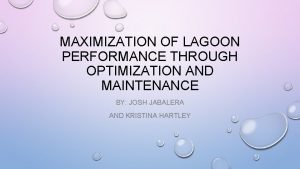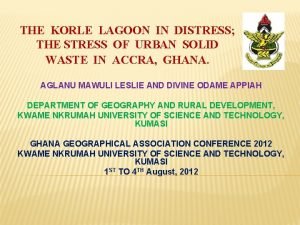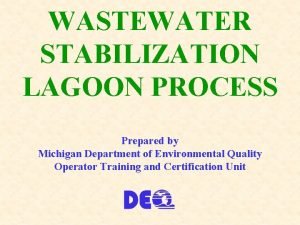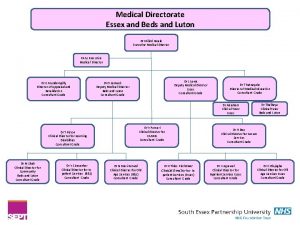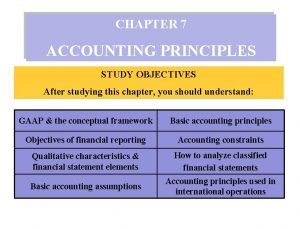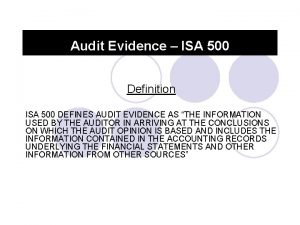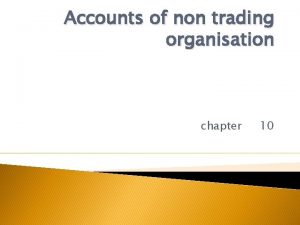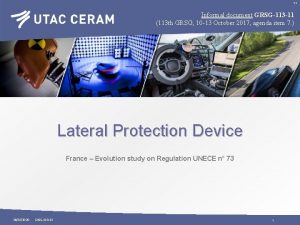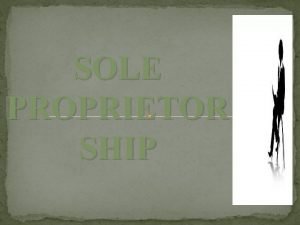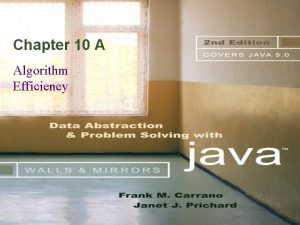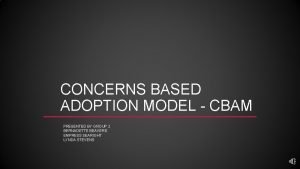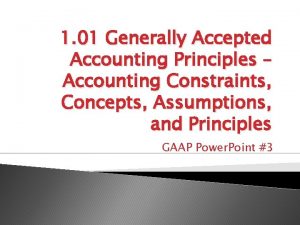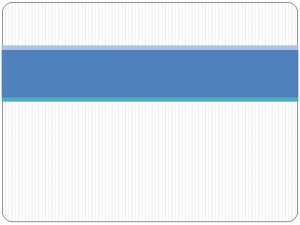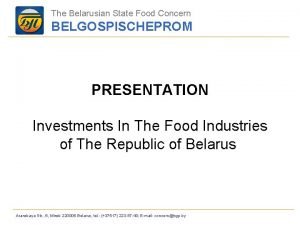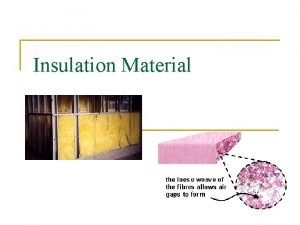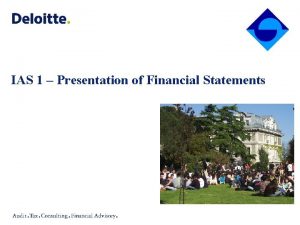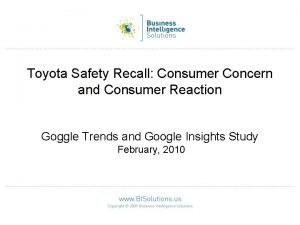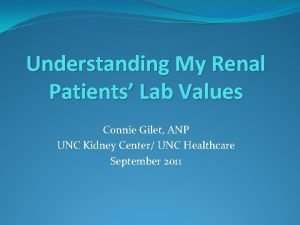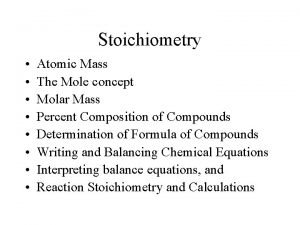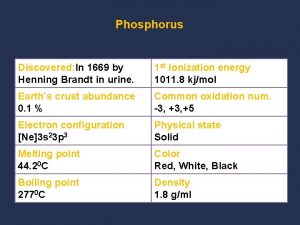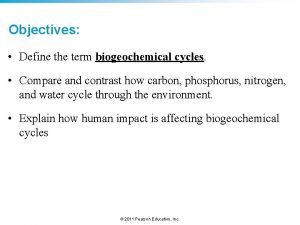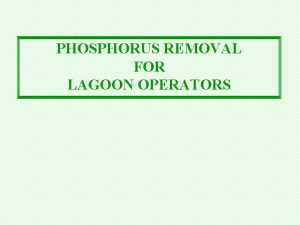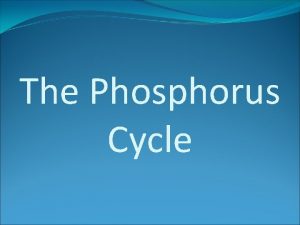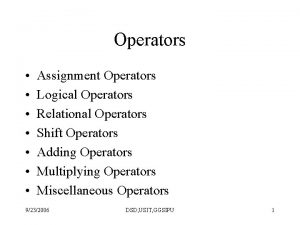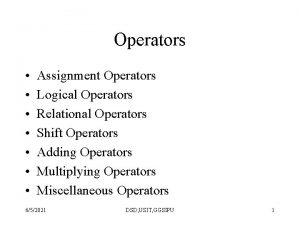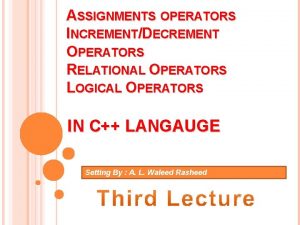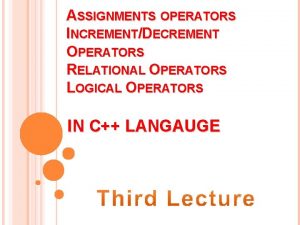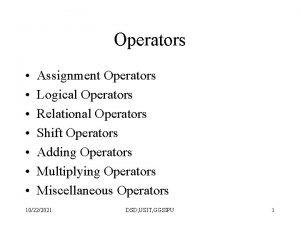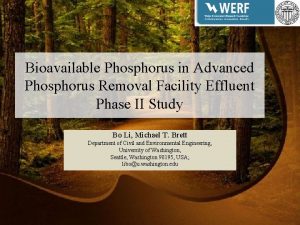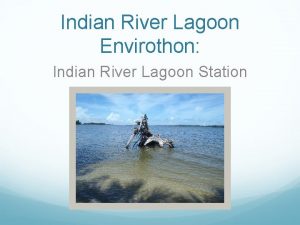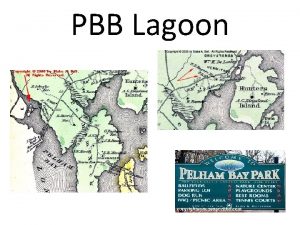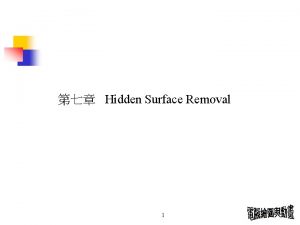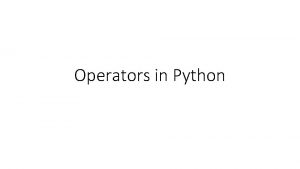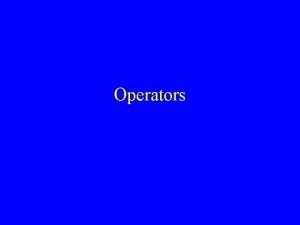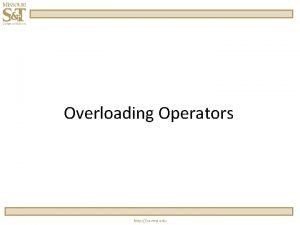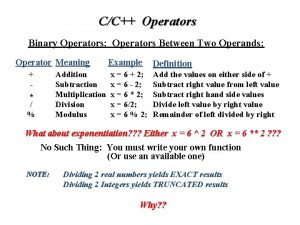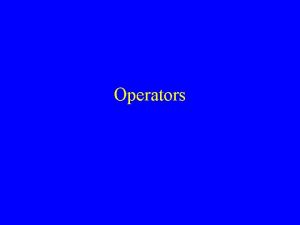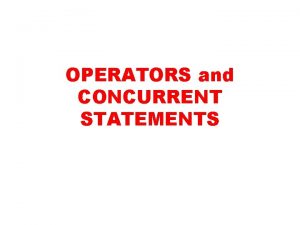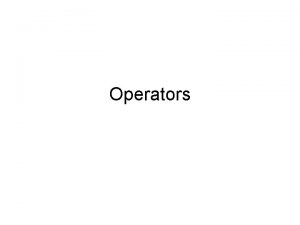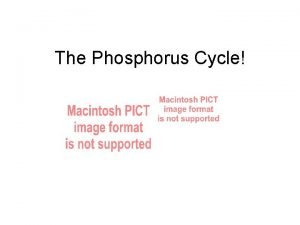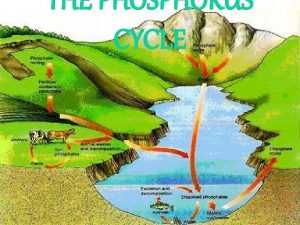PHOSPHORUS REMOVAL FOR LAGOON OPERATORS WHY THE CONCERN





















































- Slides: 53

PHOSPHORUS REMOVAL FOR LAGOON OPERATORS

WHY THE CONCERN OVER P

Eutrophication From the Greek word “Eutrophos”, meaning “well nourished” Describes the biological reactions of aquatic systems to nutrient enrichment Natural aging process

“Eutrophos”, meaning “well nourished” Biological reactions of aquatic systems to nutrient enrichment Natural Aging Process

Eutrophication Rate of Eutrophication is increased by human activities (Cultural Eutrophication) Development Stormwater Run-Off Agriculture Wastewater Discharges WWTP On-Site Systems Combined Sewer Overflow

Control of Eutrophication Control Development Weed Control Mechanical Chemical Control Discharge of Nutrients Organics Nitrogen Phosphorus

Control of Eutrophication - Nutrient Control Nitrogen Essential Nutrient Very available in nature Not practical to control

Control of Eutrophication - Nutrient Control Phosphorus Essential Nutrient Not easily replaced in nature P removal is practical The Phosphorus Cycle

Forms and Sources of Phosphorus Orthophosphate • Simple Phosphate, PO 4 • soluble • household cleaning agents • industrial cleaners; phosphoric acid

Forms and Sources of Phosphorus Polyphosphate (condensed phosphate) • more complex, chained molecules • soluble • home, industrial detergents • potable water treatment • decomposes to Ortho-P

Forms and Sources of Phosphorus Organic Phosphorus • complex organic compounds • soluble or particulate • decomposes to Ortho-P

Phosphorus Removal • Removal of Settleable Solids Provides Some Phosphorus Removal Primary Sedimentation 5 - 15 % • Biological Wastewater Treatment Systems Will Remove Phosphorus 100: 5: 1 (C: N: P) Primary and TF 20 - 30 % Primary and AS 30 - 50 % • Total Influent P Typically 4 - 6 mg/L • NPDES Permits Limit Effluent P 1 mg/L and Lower

Phosphorus Removal of Ortho-P may Occur Through: 1. Enhanced Biological Uptake 2. Chemical Precipitation

Treatment Process Precip itation Coagulation Flocculation Separation

Phosphorus Removal Chemical Precipitation • Organic and Condensed Phosphorus Compounds Must Be Converted to Ortho-P for Efficient P Removal

Chemical Phosphorus Removal Soluble Phosphate plus Metal Salts form Insoluble Phosphorus Compounds

Chemical Removal M+3 + PO 4 -3 ( M+3 = Metal in Solution ) MPO 4 PRECIPITATION Metals used are: Aluminum, Al Iron, Fe

Chemicals Used for Precipitation Most Common in Michigan: Alum Ferric Chloride

FERRIC IRON - Fe+3 M+3 + PO 4 -3 Fe+3 + PO 4 -3 MPO 4 Fe. PO 4 Weight Ratio Fe+3 to P 1. 8 : 1 Fe. Cl 3 : P 5. 2 : 1 Starting Dosage 20 -25 mg/L

ALUMINUM COMPOUNDS Aluminum Sulfate (Alum) Al 2(SO 4)3. 14 H 2 O Sodium Aluminate Na 2 Al 2 O 4 Aluminum Chloride Al. Cl 3

Alum Dosage Rates Al 2(SO 4)3 + 2 PO 4 -3 2 Al. PO 4 Weight Ratio Al+3 : P 0. 87 : 1 Alum to Phosphorus 9. 6 : 1 Starting Dosage 40 -50 mg/L

Phosphorus Removal Chemical Precipitation • Organic and Condensed Phosphorus Compounds Must Be Converted to Ortho-P for Efficient P Removal AFTER PRIMARY POND





Treatment Process Precipitation Coagulation Flocculation Separation

FLASH MIX TANK Impeller Overflow Feed

FLASH MIX TANK

FLOCCULATION TANK Impeller Lower Overflow RPM Feed

Clarifier

t uen Influ Effl ent Clarifier Sludge Removal

Typical Mechanically Mixed Flocculating Clarifier Circular Baffle Slow Mixers n tio la r cu be oc m Fl Cha Influent Effluent




PHOSPHORUS REMOVAL FOR LAGOON OPERATORS DOSAGE CALCULATIONS

BENCH ANALYSIS OF A CHEMICAL REMOVAL SYSTEM (JAR TEST)

After jar testing has been used to determine best chemical dosage in mg/L, pounds of chemical needed into a given flow or volume can be calculated. Pounds/day = Conc, mg/L X Flow, MGD X 8. 34 lbs/gal ie) A dosage of 25 mg/L Ferric Chloride is needed. The flow to be treated is 350, 000 gallons per day. How many lbs of Ferric Chloride will have to be fed each day? lbs/D = 25 mg/L X 0. 35 MGD X 8. 34 lbs/gal = 73 lbs/D Fe. CL 3

Given lbs/d of dry chemical to feed, need to calculate the gallons of solution to feed. Specific Gravity = the number of times heavier or lighter the solution is than water 1 gallon of water weighs 8. 34 lbs Specific gravity of water = 1. 000

Specific Gravity If a solution has a Specific Gravity of 1. 510, then this solution is 1. 510 times heavier than water. 8. 34 lbs/gal X 1. 510 = 12. 59 lbs/gal

Chemical Handling Strength of Concentrated Solutions are usually given as Percent by Weight 35 % = 35 per 100 35 lbs dry chem 35 % = 100 lbs solution In 100 lbs of a 35 % solution there are 35 lbs of dry chemical

If the weight of a gallon of solution is known, the weight of dry chemical in each gallon of the solution can be calculated: A 40% solution has a specific gravity of 1. 43 A. Determine the weight of a gallon of the solution. 8. 34 lbs/gallon X 1. 43 = 11. 93 pounds per gallon liquid B. Determine the pounds of dry chemical in each gallon. 11. 93 pounds X 40 lbs dry chem = 4. 77 lbs dry chem/ gal 100 lbs solution OR 11. 93 pounds X 0. 40 = 4. 77 lbs dry chem/ gal

Feed Rates If the lbs per day of chemical to be fed is known, and we know the pounds of dry chemical in each gallon of the solution, the gallons per day of solution to be fed can be calculated. lbs/day dry chem needed = gal/day soln to be fed lbs dry chem / gal

ie) 150 lbs per day ferric chloride are to be fed. The solution to be used is 38% with a specific gravity of 1. 413. Calculate the gallons of solution to feed each day. 8. 34 lbs/gal X 1. 413 = 11. 78 lbs/gal 0. 38 X 11. 78 lbs/gal = 4. 48 lbs dry chem/gal 150 lbs/d dry chem needed = 33. 5 gal/day 4. 48 lbs dry chem/gal

Pumping Rate Calculations Given gallons per day of chemical needed, calculate gallons per minute Gal X Day 1 Day X 24 Hrs 1 Hr = 60 Min Gal Min


Pumping Rate Calculations Given gallons per day of chemical needed, calculate gallons per minute Gal X Day 1 Day X 24 Hrs 1 Hr = 60 Min Gal Min m. L Sec 1 Gal X 3785 m. L 60 Sec = Min Gal Min X

Chemical Feed Summary 1. Determine lbs/day of dry chemical needed. mg/L X MGD X 8. 34 lbs/gal = lbs/d dry chem 2. Determine the weight (lbs/gal) of the soln. 8. 34 lbs/gal X Sp. Gr. = lbs/gal (liquid weight) 3. Determine weight of dry chem in each gallon. lbs/gal (liquid wt) X % soln = lbs dry/gallon 4. Determine gallons per day to be fed. Lbs dry needed per day = gal/day to be fed lbs dry/gallon 5. To Determine pumping rate in gallons/minute: gal X 1 Day 24 Hrs X 1 Hr = Gal Min 60 Min 6. Calibrate the chemical feed pump.

Phosphorus Removal Dosage Calculations Example Problem Jar testing indicates that a dosage of 23 mg/L of ferric chloride will be needed to provide adequate treatment of a lagoon with a volume of 3. 5 MG. The ferric chloride solution has a concentration of 40 % and a specific gravity of 1. 430. Calculate the gallons of the ferric chloride solution that should be used. Calculate the pounds of dry chemical that are needed. 23 mg/L X 3. 5 MG X 8. 34 lbs/gal = 671. 37 lbs

Phosphorus Removal Dosage Calculations Example Problem Jar testing indicates that a dosage of 23 mg/L of ferric chloride will be needed to provide adequate treatment of a lagoon with a volume of 3. 5 MG. The ferric chloride solution has a concentration of 40 % and a specific gravity of 1. 430. Calculate the gallons of the ferric chloride solution that should be used. Calculate the pounds of dry ferric chloride in each gallon of the solution. 8. 34 lbs/gal X Sp. Grav. X % Solution = lbs dry ferric chloride / gallon of solution 8. 34 lbs/gal X 1. 430 X 0. 40 = 4. 77 lbs dry ferric chloride / gallon of solution

Phosphorus Removal Dosage Calculations Example Problem Jar testing indicates that a dosage of 23 mg/L of ferric chloride will be needed to provide adequate treatment of a lagoon with a volume of 3. 5 MG. The ferric chloride solution has a concentration of 40 % and a specific gravity of 1. 430. Calculate the gallons of the ferric chloride solution that should be used. Calculate the gallons of ferric chloride solution needed. 671. 37 lbs dry ferric chloride needed 4. 77 lbs dry ferric chloride / gallon solution = 140. 75 gallons of ferric chloride solution needed

PHOSPHORUS REMOVAL FOR LAGOON OPERATORS
 Lagoon phosphorus removal
Lagoon phosphorus removal Hey hey bye bye
Hey hey bye bye Water pollution and unequal distribution illustration
Water pollution and unequal distribution illustration Why is water pollution of great concern in southwest asia
Why is water pollution of great concern in southwest asia Optimize wastewater lagoon
Optimize wastewater lagoon What is a lagoon
What is a lagoon Lagoon city map
Lagoon city map The black lagoon toronto
The black lagoon toronto Egg processing lagoon
Egg processing lagoon Korle lagoon ecological restoration project
Korle lagoon ecological restoration project Lagoon
Lagoon Spit formation
Spit formation Lagoon ward brockfield house
Lagoon ward brockfield house Dont ask why why why
Dont ask why why why Thematic concern
Thematic concern Accounting assumptions
Accounting assumptions Age concern gosport
Age concern gosport Going on concern principle
Going on concern principle 2010
2010 What is the going concern assumption
What is the going concern assumption Audit evidence isa 500
Audit evidence isa 500 What do you mean by non trading organisation
What do you mean by non trading organisation Accounting the language of business
Accounting the language of business Growing concern grade 11, 1150l
Growing concern grade 11, 1150l Going concern princip
Going concern princip Teorija i politika bilansa
Teorija i politika bilansa Central city concern housing office
Central city concern housing office Sources of content analysis
Sources of content analysis The owners of a small manufacturing concern have hired
The owners of a small manufacturing concern have hired Introduction of sole proprietorship
Introduction of sole proprietorship Algorithm efficiency is typically a concern for
Algorithm efficiency is typically a concern for Iowa concern hotline
Iowa concern hotline Concerns-based adoption model
Concerns-based adoption model Sole trading concern features
Sole trading concern features The going concern assumption assumes that the business
The going concern assumption assumes that the business What do you mean by the term accountancy of lawyers
What do you mean by the term accountancy of lawyers Belarusian state food industry concern
Belarusian state food industry concern Most letter formats require single spacing
Most letter formats require single spacing Prime concern
Prime concern Going concern assumption
Going concern assumption Toyota concern
Toyota concern Kontinuitetshantering i praktiken
Kontinuitetshantering i praktiken Elevated phosphorus
Elevated phosphorus Molar mass of sucrose
Molar mass of sucrose Soybean phosphorus deficiency
Soybean phosphorus deficiency Henning brandt
Henning brandt Difference between phosphorus cycle and carbon cycle
Difference between phosphorus cycle and carbon cycle Novell typiska drag
Novell typiska drag Tack för att ni lyssnade bild
Tack för att ni lyssnade bild Vad står k.r.å.k.a.n för
Vad står k.r.å.k.a.n för Shingelfrisyren
Shingelfrisyren En lathund för arbete med kontinuitetshantering
En lathund för arbete med kontinuitetshantering Personalliggare bygg undantag
Personalliggare bygg undantag What foods contain high phosphorus
What foods contain high phosphorus




